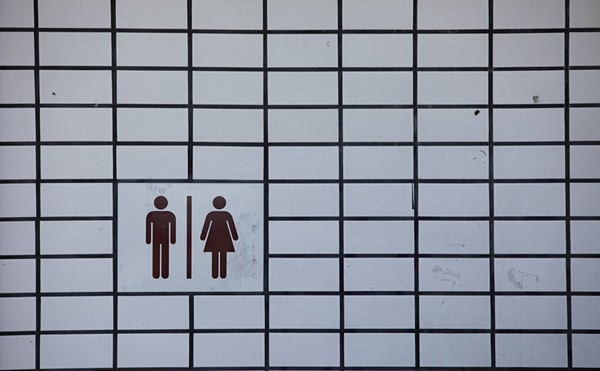And yet American Greetings Chairman Morry Weiss is Cleveland's highest-paid CEO.
Earlier this year, the company paid Weiss a $1.9 million bonus in addition to his $619,000 yearly salary and $185,000 in insurance premiums. He isn't the only executive whistling through the recession. New President James Spira got $3.1 million in cash and stock this year. Jeffrey Weiss, head of the North American card division and Morry's son, took home a package worth more than $920,000.
But a few months before the handsome rewards were dispensed, the company printed its annual report. For fiscal 2002, the company announced a net loss of $122 million. The year before, it lost $114 million.
There is a method to the mad money, company officials say. Or at least a method that makes sense in present-day corporate America.
A year and a half ago, American Greetings' leaders, confronted by slow card sales, put the company on a diet. A goal was set: Trim $90 million in costs. Most of the savings was found in manufacturing. Plants were closed, 1,600 workers laid off, and card offerings reduced by a third. "We took some tough medicine," says Jeff Petit, vice president of communications.
For swallowing hard, first-flight employees were rewarded. About 700 people -- in a company that employs 20,000 full-time -- had bonuses tied to downsizing. "It's very unusual," Petit says, adding that bonuses the year before were "minuscule." Indeed, Weiss ranked 30th on Crain's 2001 CEO pay list.
But as Weiss and the others enjoy this year's bounty, many shareholders are waiting to break even (to say nothing of the field hands learning the ways of unemployment). According to the company's proxy statement, a $100 investment in American Greetings in February 1997 was worth $51 five years later. In the same time, a $100 investment in the S&P 500 would have grown to $150. "It certainly hasn't been a great performer," says stockholder Miles J. Smith Jr. of South Carolina.
Officials say the company's dull performance is old news. The darkest day was probably November 16, 2000, when American Greetings announced lower than expected earnings and cut its dividend. In 24 hours, the share price had fallen 42 percent.
American Greetings is now lean and poised, it claims. In March, earnings exceeded expectations, and the stock price made its greatest one-day leap in history. The surge, however, recovered only a portion of what had been lost. After peaking at $53 a share in 1998, a piece of American Greetings now trades for $14.
Put another way, executives were slapping high fives for slam-dunking on a six-foot hoop.
Little wonder the stock market is in the dumps.
Started in 1906 by Jacob Sapirstein, a Polish immigrant who peddled postcards by horse-drawn wagon, American Greetings posted solid earnings for decades. Sales crossed $1 million in 1940, $100 million in 1968. And unlike most large employers in Northeast Ohio, art and prose -- not muscles and machines -- powered its success. The talent roster at one time included Tom Wilson, creator of Ziggy, and R. Crumb, who later drew the X-rated Felix the Cat.
Crumb didn't fit in, but it's not hard to find current and former employees who swear by the place. Its Brooklyn headquarters is a bland office park hidden behind a drive-in theater on Tiedeman Road, but inside, the atmosphere is polite, respectful, even whimsical. The company sanctions spelling bees, pumpkin carvings, and kite-flying contests. "It's like working at a family delicatessen," an employee once said.
American Greetings is both a family business and a multinational corporation. While its stock trades publicly, the voting shares are controlled by Sapirstein's descendants. His son Irving Stone -- he and his brothers changed their names in the 1940s -- ran the company for much of its existence. Stone was so involved in the process, he wrote verse and personally approved every sentiment before it left the building. He died two years ago, at age 90. Weiss, the current CEO, married one of Stone's daughters, and three of their sons are vice presidents.
"It's a pretty unique family that has in its bloodlines this ability and this love for the whole greeting card category," Petit says. "There's this passion for it. And it's kind of a good thing. There's a certain stability and a heritage and a legacy that they bring to us."
Until recently, stability and heritage served the company well. American Greetings was never able to overtake Hallmark, but in a $7 billion industry, second place is no disgrace. One analyst says the company's bad years were still profitable. After all, even atheists send Christmas cards. Today the "social expression" business is a virtual duopoly, with Hallmark and American Greetings accounting for about 85 percent of all card sales.
Then, about five years ago, card buying stalled. Company leaders don't know why, but congratulations and sympathies aren't filling mailboxes as they once did. "There's this whole art of social graces that's gone," Petit says.
As officials see it, the company is largely a victim of circumstance. Society is less thoughtful, and retailers are more demanding. The latter is certainly true. Five mega-retailers account for 37 percent of the company's sales. "In the past, they were able to raise prices pretty freely," says Eric Bosshard of Midwest Research. "Now the Wal-Mart effect on greeting cards has been to make prices go down rather than up."
Still, a tightening market does not account for all the losses. Bad management also played a role.
In the early '90s, the company had high hopes for CreataCard: computer kiosks that allowed customers to personalize and print their own greeting cards. Ten thousand were parked in retail stores nationwide. Card buying is an almost exclusively female endeavor, and it was thought that men especially would appreciate a gadgety alternative to the traditional racks of puppies and sunsets.
But CreataCard flopped. The $3.95 cards took 10 minutes to print -- too expensive and too slow for men and women alike. In November 1995, the company announced that net income would shrink by $48 million, largely because of the huge outlay and tiny returns on CreataCard. (Hallmark also invested in a similar project, though not to the level American Greetings did.)
CreataCard's failure prompted two shareholder lawsuits. In one case, a foundation that had purchased 2,000 shares charged the company with concealing CreataCard's woes and defrauding the market. The suit also alleged that three executives -- including then-President Ed Fruchtenbaum -- had sold $983,600 worth of stock seven months before reducing CreataCard's assets by $52 million. The company said that CreataCard was a disappointment, not fraud, but later paid $1.5 million to settle the case. The other suit, brought by a group of investors who received shares of American Greetings stock in exchange for the CreataCard technology, was also settled out of court.
In spite of the debacle, American Greetings was smitten by the next technological innovation: the Internet. Since 1995, the company has spent about $100 million on AmericanGreetings.com, which allows users to send cards via e-mail.
For American Greetings to embrace the web was sort of like Woody Hayes adopting a run-and-shoot offense. Previously, the company diversified by buying makers of like-minded products: party supplies, reading glasses, candles, etc. But with the dot-com unit, it tried to mimic a Silicon Valley start-up.
AmericanGreetings.com occupied a snazzy building separate from the mothership and struck a hip pose. Artists and technicians brought their pets to work, played foosball, and bounced to pop hits, including the Barenaked Ladies' "If I Had $1000000." The song captured the expectant mood. Workers were promised shares of the dot-com unit when the subsidiary was taken public. According to a former employee, a manager once wore a T-shirt that read "IPO this."
The Internet mantra of the day was "get big fast." In the dash for page views, American Greetings bought up smaller dot-coms and paid lavishly to link up with online services. In 1999, American Greetings agreed to pay $20 million a year to be AOL's exclusive e-card provider. (The deal was later renegotiated.)
But, like so many other online ventures, AmericanGreetings.com put too much emphasis on eyeballs and not enough on wallets. The site was popular, but didn't bring in revenue. The IPO was delayed, then canceled. "It just grew too fast, and there wasn't a lot of thought put into it," says a former dot-com employee. "The business people were just clueless."
Says another former dot-commer: "I don't think they spent enough time understanding the technology they needed to grasp."
There was also the question of whether the company's quaint fare -- the "Reader's Digest of greeting cards," an analyst once called it -- had kept up with the times. Two years ago, AmericanGreetings.com rolled out the colorful Bubblegum crew. Bubblegum allowed online users to assume alter egos and jazz up their e-mails with animated characters. There were 29 Bubblegum characters in all, including Disco Diva, Cool Dude, Easy, and Smile. The "fresh 'n' funky, fun 'n' flirty" personalities seemed better targeted for second-graders than the 18-to-24 crowd the company had in mind. One troubled investor, ranting on a financial website, called American Greetings' online offerings "lame."
Company officials say that too much has been made of the online experiment. The $100 million investment represents less than 2 percent of its annual revenue. It is hoped that a scaled-down AmericanGreetings.com, which now charges $11.95 annually for unlimited use, will break even this year. Officials also reject the theory that the Internet stole focus from the core business, which turned radioactive. American Greetings' five-year stock chart resembles that of a horny start-up, not a corporation nearing its 100th anniversary.
In February 1999, American Greetings announced that in response to stores wanting fewer cards, it would ship $100 million less in inventory. The stock fell 32 percent. Later that year, the company restructured its Canadian operations and closed a Toronto plant. André Foucault, secretary-treasurer of the Communications, Energy & Paperworkers Union of Canada, says workers felt betrayed. American Greetings had been a fair employer, and the plant turned a profit, Foucault says. "I had a sense that there was a lack of creativity on [management's] part. It was like a siege mentality."
It didn't end there. In the summer of 2000, Fruchtenbaum resigned abruptly and was replaced with Spira, a consultant who had served on the board of directors. In November of that year, the company, citing weak sales, surprised Wall Street by cutting its dividend nearly in half. The stock fell another 42 percent. A few months later, when American Greetings needed to refinance its debt, some of its bonds sold at junk rates. The investment community, tired of disappointment, spanked the company. "You make enough bad forecasts, it does damage to your reputation," Grodsky says.
Weiss later admitted that company leaders didn't realize the extent of their problems. "It turned out the issues of inventory were greater than we thought at the time, pricing was a greater problem than we thought, and the Internet was a greater challenge," he told The Plain Dealer.
Other than that, things were fine.
American Greetings is not teetering on the edge of bankruptcy. There are no reports of financial officers finishing multimillion-dollar homes in Boca Raton. It is a real company that makes things.
And it now appears to have taken a grip. John Miller, a portfolio manager at Ariel Capital Management, which owns 19 percent of the company's common stock, applauds Spira for shaking the company from its slumber. "I think he's outstanding," Miller says. Bosshard says American Greetings is "doing more right than wrong." Zacks Investment Research put the company on its August list of recommended stocks.
But if American Greetings is not emblematic of corporate chicanery, it is symptomatic of loosened standards and executive entitlement. Creative accounting, for instance, resulted in a $143 million charge on 2001 earnings. American Greetings had taken out what is known as "janitors insurance," in which a company buys insurance policies on even the lowest of employees, with itself named as the beneficiary. Aside from the death benefit, the insurance allows companies to borrow against the policies and deduct the interest.
Some of the nation's largest companies bought janitors insurance. American Electric Power in Columbus has policies on 20,000 employees; Wal-Mart took out 350,000 policies. "We had some people on it, but not everyone," says American Greetings' investment relations manager, David Poplar.
But then the IRS took notice. According to The Wall Street Journal, the IRS is investigating more than 85 companies it believes took $6 billion in illegal deductions. The $143 million represents seven years of taxes and interest American Greetings may have to pay. The company is also being pursued by the State of Iowa for taxes that might have been hidden by divisions incorporated in Delaware.
And then there's the stock options.
A stock option offers the right to buy stock at a fixed price at some time in the future. Options are designed to keep executives focused on the company's stock price. If the stock rises, the executive profits from the opportunity to buy today's shares at yesterday's prices.
Once obscure, options were popularized by high-tech firms big on ideas, but low on cash. By the mid-'90s, every self-respecting CEO and his top deputies sat on mountains of them. Disney Chairman Michael Eisner, for instance, made $565 million in options in 1997. A few lonely souls (Fed boss Alan Greenspan and superinvestor Warren Buffett, to name two) questioned the odd ways companies were allowed to account for options on their balance sheets, but with the Dow and NASDAQ clicking, why spoil the fun?
Now, of course, the fun is gone, and many experts think options are the main reason why so many companies got so sleazy. "Stock-options culture is at the root of the current scandals on Wall Street," wrote retired J.P. Morgan Vice President Walter M. Cadette in The New York Times. Reagan-era Fed chairman Paul Volcker told The New Yorker that stock options should be abolished.
American Greetings, in many ways, presents the case why.
The company bought into the theory that options align the interests of executives and shareholders, and were necessary to attract and retain talent. Its program was expanded in 1997. Between them, Weiss and Spira were granted 630,000 options last year.
"It's just like being any other shareholder," Petit says. "It's not a gift. You have to take a risk on when you sell your shares, just like any other shareholder."
Not exactly. Option holders have no risk of loss. If a stock is trading below the option price, they simply don't exercise it. But when the stock trades above, they can profit instantly. Not only is it a sure thing, but at companies like American Greetings, option holders never put up their own money. The company covers the purchase price until the stock is sold. At best, options dilute shareholder wealth by giving away profits for nothing. At worst, they create a perverse incentive for insiders to prop up the stock price, consequences be damned. Enron, Global Crossing, and WorldCom all lavished options on their executives, who made out before the house of cards collapsed.
The SEC's civil case against former American Greetings President and Chief Operating Officer Ed Fruchtenbaum does not allege that he or other company officials inflated earnings. It does, however, reveal the options system's inherent flaws.
In December 1998, Fruchtenbaum exercised options to buy 30,000 shares of American Greetings stock at prices ranging from $19 to $30 a share. At the time, the stock fetched $40 on the open market. If he bought the shares and sold them immediately, he would rake in a pile of money. Fruchtenbaum did precisely that.
Two months later, American Greetings announced its inventory reduction plan, and the stock fell dramatically. By trading before the announcement, Fruchtenbaum made $490,625 more than he would have if he had waited until February. (Prior to a 1991 SEC rule change, Fruchtenbaum would have had to hold the stock for six months before selling.)
According to the SEC's civil suit, Fruchtenbaum knew of the inventory plan in November 1998 -- a month before his sell-off. The SEC further alleges that Weiss and a company attorney urged Fruchtenbaum not to make the trade, given the company's position.
Fruchtenbaum denies the allegations in court papers. His attorney says he wanted the money to pursue a legitimate outside investment. "The company processed the trade," lawyer Robert Tarun says. "There was never an order, 'You can't do this.'"
American Greetings officials refuse to discuss the case, saying it's a matter between Fruchtenbaum and the SEC. As a general rule, officials say, options may be exercised only at set times, typically after quarterly reports are made public. While this policy may stunt insider trading, options do little to promote company stewardship.
Of American Greetings' 10 million optioned shares outstanding, 4.3 million were issued at $9.95 -- a price near the stock's most pitiful. The performance bar, in other words, was set about as high as the curb. Poplar says the cheap options encouraged executives to stay aboard for the restructuring. "You have to start a baseline somewhere and start over," he says.
Executives didn't have to wait long to score from the new baseline. Senior Vice President Patricia Papesh, for instance, made $378,000 in one week last spring by exercising $9.95 options and then immediately selling the stock for $17 and $18. Such gains are the nature of stock options, Poplar says. "If we hadn't hit our [goal] numbers, we wouldn't be at $18."
Of course, the share price could stagnate at $18 for the next decade, and American Greetings brass will still win. By releasing so many $9.95 options, the company effectively made failure as sweet as success. In a recent New Yorker piece, financial writer John Cassidy described how companies such as Advanced Micro Devices and Oracle issued options after the price fell. "It is hard to think of a better example of what is wrong with corporate America," Cassidy concluded. "The scheme, in its audacity and its logic, is almost beautiful."
Scene attempted to talk to the board members who sit on the Compensation Committee. Former Case Western Reserve President Scott Cowen declined an interview through a spokesman at Tulane University, where he is now president. Harriet Mouchly-Weiss (Strategy XXI Group and no relation to Morry), Stephen Hardis (Axcelis Technologies), and Charles Ratner (Forest City Enterprises) did not return phone calls.
Shareholders shouldn't expect board members, who are supposed to represent their interests, to move quickly on this point. They, too, are compensated, in part, with stock options.











